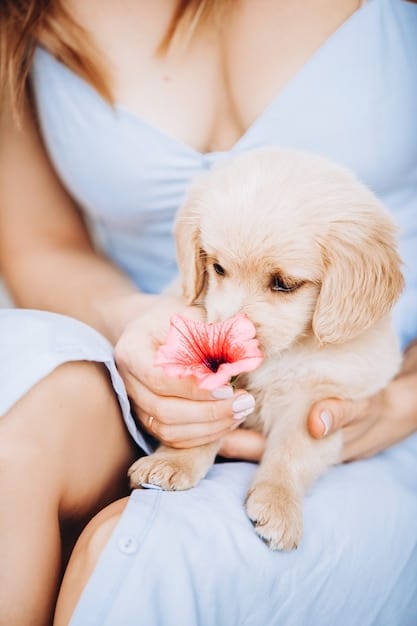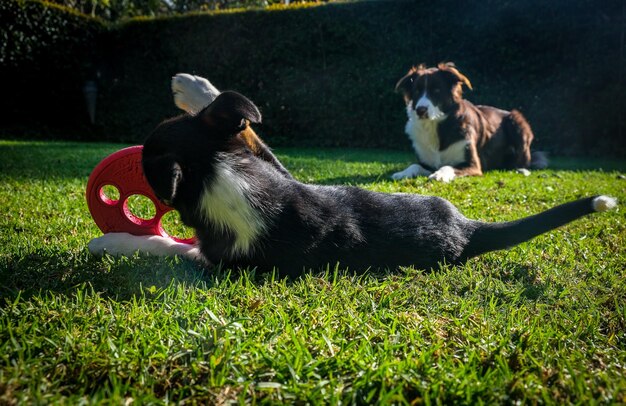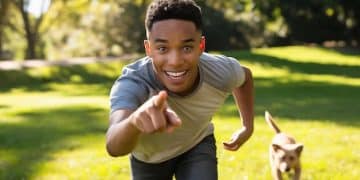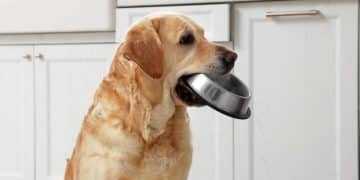Puppy Biting: Gentle & Effective Training Methods

Puppy biting can be addressed with gentle and effective training methods, including redirection, positive reinforcement, and teaching bite inhibition, ensuring a well-behaved and safe companion.
Navigating the nippy stage of puppyhood can be challenging, but understanding puppy biting: gentle and effective methods to stop puppy biting now is crucial for a harmonious relationship with your furry friend. From understanding the reasons behind this behavior to implementing practical and humane training techniques, this guide provides the knowledge you need to curb unwanted biting.
Understanding Why Puppies Bite
Puppies explore the world with their mouths, much like human babies. Biting and nipping are natural behaviors, but it’s essential to understand the reasons behind them to address them effectively. Recognizing the triggers and motivations can help you implement the right training strategies.
Here are some of the primary reasons why puppies bite:
Teething
Just like human babies, puppies experience discomfort when they’re teething. Biting and chewing provide relief from sore gums. This is a normal part of their development, but it needs to be managed to prevent it from becoming a habit.
Exploration
Puppies use their mouths to investigate their surroundings. Biting is their way of understanding textures, tastes, and objects. This exploratory behavior is common, but directed biting at humans needs correction.

Play
Puppies often engage in play biting with their littermates. They haven’t yet learned how to control the force of their bites. This behavior can transfer to interactions with humans if not properly trained during socialization.
- Recognize the signs: Learn to identify when your puppy is likely to bite, such as during play or when overly excited.
- Provide appropriate chew toys: Offer a variety of toys with different textures to satisfy their urge to chew.
- Manage their environment: Keep valuable items out of reach to prevent unwanted chewing and biting.
Understanding these reasons is the first step in addressing puppy biting. By recognizing the causes, you can tailor your training approach to be more effective and empathetic, creating a positive learning environment for your puppy.
Gentle Training Techniques to Stop Puppy Biting
When dealing with puppy biting, it’s crucial to use gentle and positive training techniques. Harsh methods can damage your relationship with your puppy and lead to fear and aggression. Positive reinforcement is key to success.
Effective gentle training techniques include:
Redirection
When your puppy starts to bite, redirect their attention to an appropriate chew toy. This teaches them that biting on toys is acceptable, but biting on skin is not. Consistency is important, so always have a toy handy.
Time-Outs
If redirection doesn’t work, a short time-out can be effective. When your puppy bites, say “Ouch!” loudly and immediately stop playing. Ignore your puppy for a few minutes to signal that biting results in the end of fun.

Positive Reinforcement
Reward your puppy when they exhibit good behavior, such as gentle play or chewing on a toy. Use treats, praise, or affection to reinforce these positive actions. This encourages them to repeat the desired behaviors.
- Consistency: Ensure everyone in the family uses the same training techniques.
- Patience: Training takes time, so be patient and persistent.
- Avoid punishment: Never hit or yell at your puppy, as this can create fear and anxiety.
These gentle training techniques are designed to help your puppy learn bite inhibition and develop good behavior. Remember, creating a positive and supportive environment is essential for successful training.
Teaching Bite Inhibition
Bite inhibition is a crucial skill for puppies to learn. It teaches them to control the force of their bites. This skill is essential for preventing injuries, especially during play or when they are startled or scared. It’s a process that involves teaching a puppy to soften their bite.
Here’s how to teach bite inhibition:
Exaggerated Reaction
When your puppy bites too hard during play, yelp loudly and withdraw your attention. This mimics the way puppies communicate with each other and teaches them that their bite hurt you. They’ll learn to associate hard biting with the end of playtime.
Gradual Pressure
Allow your puppy to mouth your hand gently. If they increase the pressure, yelp and stop playing. Gradually, they’ll learn to reduce the pressure until their mouthing is barely perceptible. This teaches them precise control over their bites.
Training Games
Engage in training games that involve mouthing. Offer your hand and encourage your puppy to mouth it gently. Reward them with treats when they comply. This reinforces the idea that gentle mouthing is acceptable, but hard biting is not.
- Supervise play: Always supervise your puppy’s playtime with other dogs and humans.
- Intervene when necessary: If your puppy’s play becomes too rough, step in and redirect their attention.
- Be consistent: Use the same cues and reactions every time your puppy bites too hard.
Teaching bite inhibition is a critical aspect of puppy training. By helping your puppy learn to control the force of their bites, you’re ensuring their safety and the safety of those around them. With patience and consistency, your puppy will develop this valuable skill.
Managing Nipping During Play
Puppies often get excited during play, which can lead to unwanted nipping. Managing this behavior requires consistent training and a clear understanding of how to redirect their energy. It’s about teaching them appropriate play behaviors.
Effective strategies for managing nipping during play include:
Using Toys
Always use toys during play sessions. This provides a physical barrier between your hands and your puppy’s mouth. Encourage them to bite and chew on the toy, instead of your skin. This helps redirect their biting instinct to something appropriate.
Short Play Sessions
Keep play sessions short and frequent. This prevents your puppy from becoming overly excited and losing control. End the session before they start to nip, reinforcing the idea that calm behavior is rewarding. This also avoids over-stimulation, which can often lead to biting.
Teaching “Leave It”
Teach your puppy the “leave it” command. This command tells them to stop what they’re doing and leave an object alone. It’s useful for interrupting nipping behavior and redirecting their attention. This is a valuable tool for overall impulse control.
- Avoid rough play: Refrain from engaging in rough play that encourages biting, such as wrestling or tug-of-war.
- Stay calm: If your puppy starts to nip, remain calm and speak in a gentle tone. Avoid yelling or getting agitated, as this can escalate the situation.
- Be proactive: Anticipate when your puppy is likely to nip and redirect their attention before they start.
Managing nipping during play is an essential part of raising a well-behaved puppy. By using toys, keeping play sessions short, and teaching commands like “leave it,” you can help your puppy learn appropriate play behaviors and prevent unwanted nipping.
The Importance of Socialization
Socialization plays a vital role in preventing puppy biting. Exposing your puppy to a variety of people, dogs, and environments helps them develop into a well-adjusted and confident adult. Socialization helps prevent fear-based aggression, which can lead to biting.
Key aspects of socialization include:
Early Exposure
Start socializing your puppy as early as possible. Between 8 and 16 weeks of age, puppies are highly receptive to new experiences. Introduce them to different sights, sounds, and smells in a controlled and positive manner.
Positive Experiences
Ensure that all socialization experiences are positive. Use treats, praise, and affection to create positive associations. Avoid overwhelming your puppy with too much stimulation, and allow them to explore at their own pace.
Controlled Interactions
Supervise all interactions with other dogs and people. Make sure the interactions are gentle and positive. If your puppy seems overwhelmed or scared, remove them from the situation.
- Puppy classes: Enroll your puppy in a puppy socialization class. These classes provide a safe and structured environment for puppies to interact with each other.
- Meet and greets: Arrange meet and greets with well-behaved adult dogs. These dogs can help teach your puppy appropriate social behavior.
- Variety of environments: Expose your puppy to a variety of environments, such as parks, stores, and public transportation. This helps them become comfortable in different settings.
Socialization is a critical component of preventing puppy biting. By exposing your puppy to a wide range of experiences and ensuring that those experiences are positive, you’re helping them develop into a confident and well-behaved adult dog. Remember, early and consistent socialization is the key to success.
When to Seek Professional Help
While many cases of puppy biting can be resolved with consistent training and socialization, there are times when professional help is necessary. If your puppy’s biting behavior is severe, persistent, or accompanied by other concerning behaviors, consult with a veterinarian, certified dog trainer, or veterinary behaviorist. Recognizing when professional help is needed is essential for your puppy’s well-being.
Signs that you should seek professional help include:
Aggressive Biting
If your puppy is biting aggressively, showing signs of growling, snapping, or lunging, it’s important to seek professional help immediately. Aggressive biting can be a sign of underlying behavioral issues that need to be addressed by an expert. This can often mean they are overstimulated.
Persistent Biting
If your puppy continues to bite despite your best efforts at training and socialization, it may be time to consult with a professional. Persistent biting can indicate that there’s an underlying issue that needs to be addressed, such as anxiety or fear.
Other Concerning Behaviors
If your puppy is exhibiting other concerning behaviors, such as excessive barking, destructive chewing, or separation anxiety, it’s important to seek professional help. These behaviors can be related to the biting and may require a comprehensive behavioral assessment.
- Veterinarian: Your veterinarian can rule out any underlying medical conditions that may be contributing to the biting behavior.
- Certified Dog Trainer: A certified dog trainer can provide guidance on training techniques and help you develop a behavior modification plan.
- Veterinary Behaviorist: A veterinary behaviorist is a veterinarian who specializes in animal behavior. They can diagnose and treat behavioral issues, including aggression and anxiety.
Knowing when to seek professional help is crucial for addressing severe or persistent puppy biting. A qualified expert can provide the guidance and support you need to help your puppy overcome their behavioral issues and develop into a well-behaved and happy member of your family.
| Key Point | Brief Description |
|---|---|
| 🐾Understanding Biting | Biting stems from teething, exploration, or play. |
| 🦴Redirection | Offer chew toys to steer biting away from skin. |
| ✋Time-Outs | End play after biting to discourage the behavior. |
| 🐶Socialization | Early exposure prevents fear-based biting. |
Frequently Asked Questions
▼
Puppy biting is often due to teething, exploration, or play. They use their mouths to learn about their environment, and it’s a natural part of their development .
▼
Redirect biting to appropriate chew toys. If they bite your hand, say “Ouch!” and stop playing. Offer a toy instead to redirect their attention.
▼
Yes, puppies often bite during play. However, it’s important to teach them bite inhibition so they learn to control the force of their bites. Reduce rough housing, as that will excite them more.
▼
Be concerned if the biting is aggressive (growling, snapping) or persistent despite training. Seek professional help if you can’t manage the behavior or if see any signs of abnormal aggression.
▼
Socialization exposes puppies to various stimuli, reducing fear and anxiety. This makes them less likely to bite out of fear or aggression. Early interaction is important, because if they miss the window, the benefits diminish.
Conclusion
Addressing puppy biting requires a combination of understanding its causes, implementing gentle training techniques, and ensuring proper socialization. Consistency and patience are key to helping your puppy learn appropriate behavior and grow into a well-behaved companion, strengthening your bond and creating a safe and enjoyable environment for everyone involved.





